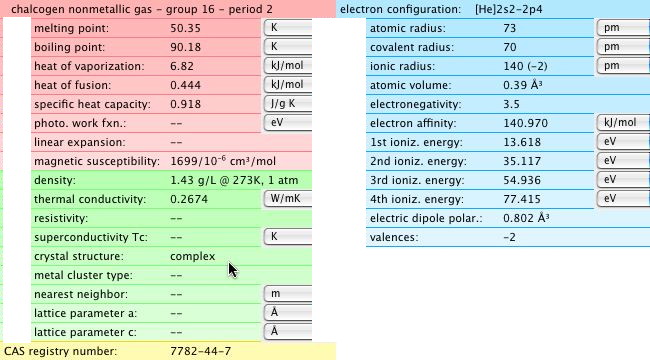Talk:Oxygen: Difference between revisions
imported>David E. Volk (more isotope discussion) |
imported>Robert Tito |
||
| Line 43: | Line 43: | ||
The one thing the CRC does list in its atomic boxes are the common oxidation states, only -2 for oxygen, but | The one thing the CRC does list in its atomic boxes are the common oxidation states, only -2 for oxygen, but | ||
+1, +2, +3, +4, +5, -1, -2, -3 for nitrogen. That could be put in the box but it would be a little messy. [[User:David E. Volk|David E. Volk]] 14:19, 18 October 2007 (CDT) | +1, +2, +3, +4, +5, -1, -2, -3 for nitrogen. That could be put in the box but it would be a little messy. [[User:David E. Volk|David E. Volk]] 14:19, 18 October 2007 (CDT) | ||
:I think that should make more impact when talking about isotopes than putting it into some figure that gets overcrowded with info. [[User:Robert Tito|Robert Tito]] | <span style="background:grey"> <font color="yellow"><b>[[User talk:Robert Tito|Talk]]</b></font> </span> 14:29, 18 October 2007 (CDT) | |||
Revision as of 13:29, 18 October 2007
I started this article because it was high on the list of most wanted articles, not because I feel especially proficient in this subject. I would like to ask for support on the biological and medical uses of oxygen, and also in making the article more attractive visually. Thanks. --Paul Wormer 04:24, 15 September 2007 (CDT)
Chemical infobox
See: Template:Chem_Infobox for a simple chemical infobox. Let me know if there's anything I should add to the template. --Robert W King 10:37, 15 September 2007 (CDT)
I'm not quite sure that this template clarifies a lot in the case of oxygen. Or maybe I do something wrong?--Paul Wormer 09:12, 16 September 2007 (CDT)
- No, it doesn't clarify a lot--it's just an infobox, nothing more. I can always add more fields to it but so far no one's ever provided any feedback on what exactly it should describe. --Robert W King 16:27, 16 September 2007 (CDT)
Robert and I are discussing putting nuclear info, like radio-active isotopes, nuclear spin, etc in the chem info box.
I was thinkng that an alternative idea would be to make an isotope_infobox, where for each isotope we list atomic mass, nuclear spin, gyromagnetic ratio or relative sensitivity (vs. 1H) or nuclear ground state. Paul, do have any thoughts on this?
David E. Volk 13:43, 18 October 2007 (CDT)
- the general idea however should be: info is good, too much info distracts and I wonder if it provides real info to somebody 'passing-by' on the page. Sure it seems more complete that way. I will upload an example from collected info using CRC's handbook.

Robert Tito | Talk 14:00, 18 October 2007 (CDT)
The stuff in the left boxes appear to be molecular properties of the O2 gas, so we are looking at the right box only? I would suggest that things like atomic radii and electronegativy won't change much by isotope (i would need to check that supposition), but nuclear spin and radioactivity change alot for isotopes, with spin states of +/-1/2 up to +/-7/2 generally, and either radioactive or not. This fact is frequently exploited with nuclear labelling in medicine (radiology, NMR, MRI) and might be of some curiosity to the person being injected with labeled isotopes before procedures.
The one thing the CRC does list in its atomic boxes are the common oxidation states, only -2 for oxygen, but +1, +2, +3, +4, +5, -1, -2, -3 for nitrogen. That could be put in the box but it would be a little messy. David E. Volk 14:19, 18 October 2007 (CDT)
- I think that should make more impact when talking about isotopes than putting it into some figure that gets overcrowded with info. Robert Tito | Talk 14:29, 18 October 2007 (CDT)
- Article with Definition
- Developing Articles
- Nonstub Articles
- Internal Articles
- Chemistry Developing Articles
- Chemistry Nonstub Articles
- Chemistry Internal Articles
- Physics Developing Articles
- Physics Nonstub Articles
- Physics Internal Articles
- Biology Developing Articles
- Biology Nonstub Articles
- Biology Internal Articles